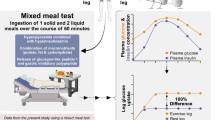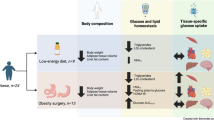Abstract
-
1.
Intragastric feeding (40 kJ) produced a 17% rise in metabolic rate in lean Zucker rats but only an 8% increase in obese (fa/fa) rats, and both of these responses were significantly reduced by β-adrenergic blockade with propranolol (10 mg/kg, s.c.).
-
2.
Parasympathetic blockade with atropine (0.5 mg/kg, s.c.) caused a doubling of the response to food in lean rats and a threefold increase in the obese mutants, such that all atropinised animals showed the same increase in metabolic rate after food.
-
3.
Feeding also caused a significant rise in interscapular brown adipose tissue temperature, which was greatest in the lean animals and was enhanced by atropine in both groups.
-
4.
Injection of noradrenaline (250 μg/kg, s.c.) caused a similar (40%) rise in metabolic rate in lean and obese animals but this response was unaffected by atropine.
-
5.
2-Deoxy-d-glucose injection (360 mg/kg, s.c.) depressed oxygen consumption by 25 and 8% in lean and obese rats respectively and this effect was totally abolished by atropine.
-
6.
These results suggest that the rise in metabolic rate after a meal is partly due to sympathetic activation of brown adipose tissue. The reduced thermic response in obese Zucker rats is not due to insensitivity to noradrenaline, but may be partly due to parasympathetic inhibition of thermogenesis and partly to insensitivity to glucose availability.
Similar content being viewed by others
References
Andrews F, Jackson F (1978) Increasing fatness inversely related to increase in metabolic rate but directly related to decrease in deep body temperature in young men and women during cold exposure. Ir J Med Sci 147:329–330
Armitage G, Harris RBS, Hervey GR, Tobin G (1981) Energy expenditure of Zucker rats in relation to environmental temperature. J Physiol 310:p 33
Cleary MP, Vasselli JR, Greenwood MRC (1980) Development of obesity in the Zucker obese (fafa) rat in the absence of hyperphagia. Am J Physiol 238:E284–292
Foster DO, Frydman ML (1978) Nonshivering thermogenesis in the rat. II Measurements of blood flow with microspheres point to brown adipose tissue as the dominant site of the calorigenesis induced by noradrenaline. Can J Physiol Pharmacol 56:110–122
Himms-Hagen J, Desautels M (1978) A mitochondrial defect in brown adipose tissue of obese (ob/ob) mouse: reduced binding of purine nucleotides and a failure to respond to cold by an increase in binding. Biochem Biophys Res Commun 83:628–634
Hirano T, Niijima A (1980) Effects of 2-deoxy-d-glucose, glucose and insulin on efferent activity in gastric vagus nerve. Experentia 36:1197–1198
Hirschwitz BI, Sachs G (1965) Vagal gastric secretory stimulation by 2-deoxy-d-glucose. Am J Physiol 209:452–460
Ikeda H, Nishikawa K, Matsuo T (1980) Feeding responses of Zucker fatty rat to 2-deoxy-d-glucose, norephinephrine and insulin. Am J Physiol 239:E379-E384
Jeanrenaud B (1978) An overview of experimental models of obesity. In: Bray GA (ed) Recent advances in obesity research, II Newman Publ London, pp 111–122
Jung RT, Shetty PS, James WPT, Barrard M, Callingham BA (1979) Reduced thermogenesis in obesity. Nature 279:322–323
Kalow W, Britt BA (1973) Drugs causing rigidity in malignant hyperthermia. Lancet II 390–391
Kaplan ML, Leveille GA (1976) Calorigenic response in obese and nonobese women. Am J Clin Nutr 29:1108–1113
King BM, Stamoutsos BA, Grossman SP (1978) Delayed response to 2-deoxy-d-glucose in hypothalamic obese rats. Pharmacol Biochem Behav 8:259–262
Lotfi M (1977) Effects of protein and energy intakes on body composition and thermogenesis. Ph D Thesis Univ London
Mayer J (1953) Glucostatic mechanism of regulation of food intake. N Engl J Med 249:13–16
Oomura Y, Ohta M, Ishibashi S, Kita H, Okajima T, Ohno T (1978) Activity of chemosensitive neurones related to the neurophysiological mechanisms of feeding. In: Bray GA (ed) Recent advances in obesity research II. Newman Publ London, pp 17–26
Purcell MJ (1966) Atropine poisoning in infancy. Br Med J i:738
Rothwell NJ, Stock MJ (1979) A role for brown adipose tissue in diet-induced thermogenesis. Nature 281:31–35
Rothwell NJ, Stock MJ (1981) Influence of noradrenaline on blood flow to brown adipose tissue in rats exhibiting dietinduced thermogenesis. Pflügers Arch 389:237–242
Rothwell NJ, Saville ME, Stock MJ (1982) Factors influencing the acute effect of food on oxygen consumption in the rat. Int J Obesity (in press)
Seydoux J, Rohner-Jeanrenaud F, Assimacopoulos-Jeannet F, Jeanrenaud B, Giradier L (1981) Functional disconnection of brown adipose tissue in hypothalamic obesity in rats. Pflügers Arch 390:1–4
Shiraishi T, Mager M (1980a). Hypothermia following injection of 2-deoxy-d-glucose into selected hypothalamic sites. Am J Physiol 239:R265-R269
Shiraishi T, Mager M (1980b) 2-Deoxy-d-glucose-induced hypothermia: thermoregulatory pathways in the rat. Am J Physiol 239:R270-R276
Smith GP, Epstein AN (1969) Increased feeding in response to decreased glucose utilization in the rat and monkey. Am J Physiol 217:1083–1087
Stock MJ (1975) An automatic closed-circuit oxygen consumption apparatus for small animals. J Appl Physiol 39:849–800
Thurlby PL, Trayhurn P (1979) The role of thermoregulatory thermogenesis in the development of obesity in genetically obese (ob/ob) mice pair fed with lean siblings. Br J Nutr 42:377–385
Trayhurn P, James WPT (1978) Thermoregulation and non-shivering thermogenesis in genetically (ob/ob) mouse. Pflügers Arch 373:189–193
Trayhurn P, Thurlby PL, James WPT (1976) A defective response to cold in the obese (ob/ob) mouse and the obese Zucker (fafa) rat. Proc Nutr Soc 35:133A
Wimpfheimer C, Saville ME, Voirol MJ, Danforth E, Burger AG (1979) Starvation induced decreased sensitivity of resting metabolic rate to triiodothyronine. Science 205:1272–1273
Young RA, Tulp OL, Horton ES (1980) Thyroid and growth responses of young Zucker obese and lean rats to a low protein — high carbohydrate diet. J Nutr 110:1421–1431
Author information
Authors and Affiliations
Rights and permissions
About this article
Cite this article
Rothwell, N.J., Saville, M.E. & Stock, M.J. Acute effects of food, 2-deoxy-d-glucose and noradrenaline on metabolic rate and brown adipose tissue in normal and atropinised lean and obese (fa/fa) Zucker rats. Pflugers Arch. 392, 172–177 (1981). https://doi.org/10.1007/BF00581268
Received:
Accepted:
Issue Date:
DOI: https://doi.org/10.1007/BF00581268




